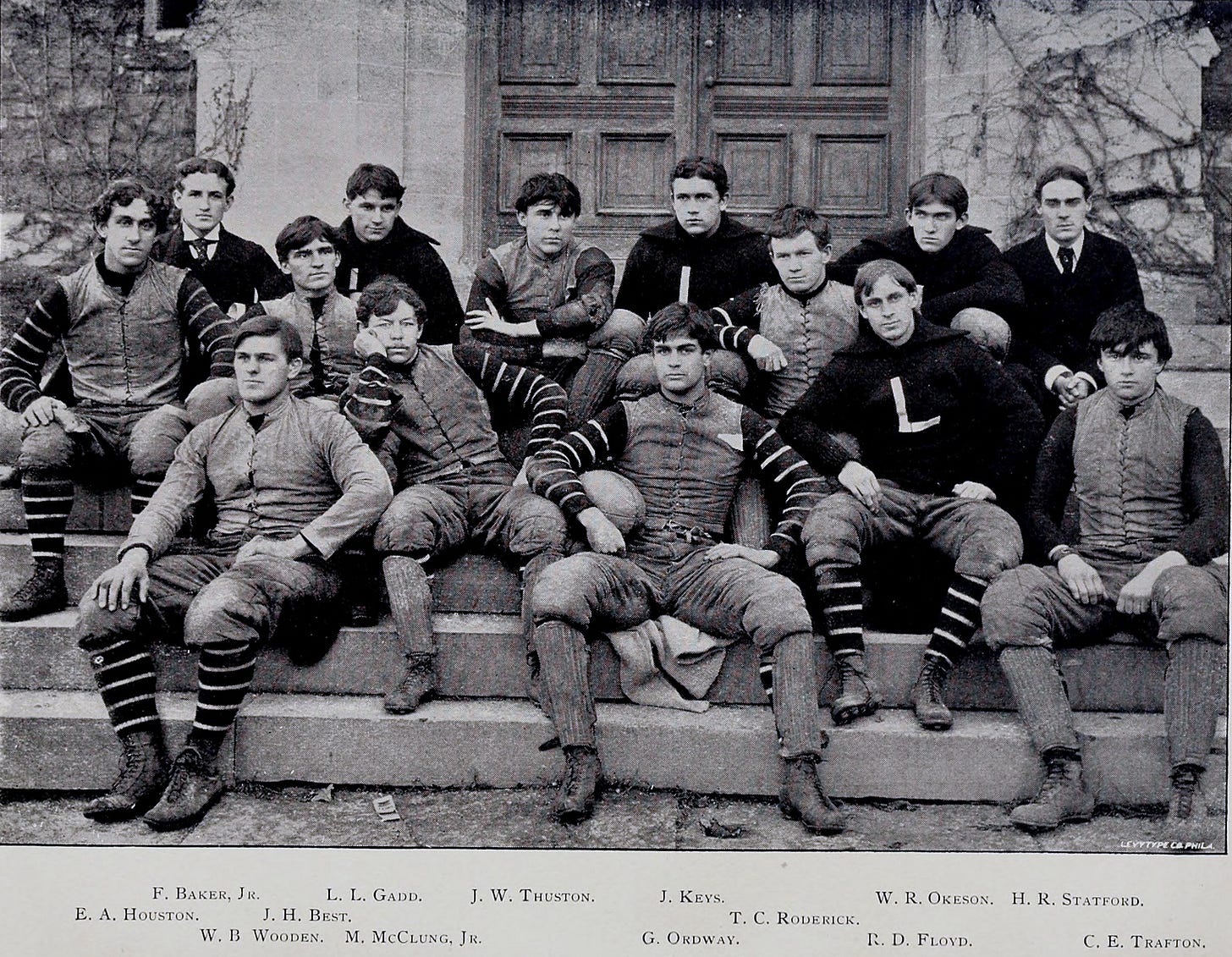Today's Tidbit... 1876 IFA Rule #57: Hacking
This is #57 in a series covering football's original 61 rules adopted by the Intercollegiate Football Association in 1876. We review one rule each Friday.
Hacking has a different meaning today than in 1876, but if you have ever wondered why football players in early photographs wear shin guards, it was due to hacking. Hacking is kicking an opposing player in the shins to cause pain or injury.

In rugby's early days, hacking was common, and wearing shin guards was frowned upon because real men could withstand a good hack. But as rugby and soccer were formalizing and splitting apart, the Rugby Union made hacking illegal in 1871, and "hacking over" became illegal in 1874. Their rule covering hacking is identical to the IFA’s Rule 57.
Rule 57: No hacking or hacking over or tripping up shall be allowed under any circumstances.
(To clarify, hacking was kicking the shins from straight on," hacking on" was the artful striking of an opponent's shin from the side, and tripping was tripping. All were illegal, but they continued to occur during play.)
A key point about rugby and football in 1876 was that the game resembled a 15-player maul or something resembling today’s Tush Push. Teams pushed and kicked the ball toward the opponent's goal line, and with 15 players per side, the ball largely stayed inside the maul, so players were hacked, intentionally or not.
Snapping the ball back was not illegal, but it was frowned upon. When the American game switched from 15 to 11 players per side, as advocated by Walter Camp, the ball leaked out of the maul more easily, so they passed the ball to backs who tried sweeping around the end. The sweeping and lateraling game that is rugby today did not become part of their game until the 1880s, or after it was part of gridiron football. Of course, American rule changes allowing tackling below the waist reduced the effectiveness of sweeps and sent us down the power football path rather than keeping the open game.
Still, American football did not immediately switch to the sweeping game. It retained elements of the maul for several decades, particularly in the rules for the snap and the start of a scrimmage. For example, the 1883 rule book tells us that the scrimmage started when the center or snapperback kicked or snapped the ball.
Since the center could kick the ball forward, opponents defended against it by placing men in the middle and jostling the center as he attempted to snap the ball. If his foot slipped off the ball, the ball became live -the same as any kick- and recoverable by either side.
Despite the rule remaining in the books that snappers could kick the ball forward, teams increasingly found it more productive to snap the ball back. Yale exploited that situation in 1887 when their center, Pa Corbin, kicked the ball forward and picked it up on several key plays to score a touchdown against Harvard. That led to a rule clarification that allowed the center to pick up the ball when he kicked it forward but made him ineligible to carry it when snapped back until at least one teammate possessed the ball.
Through 1909, the same rule remained in place, so centers could kick or snap the ball, though kicking the ball became rare because centers switched to snapping with their hands rather than their feet in the early 1890s.
Finally, the rules of 1910 eliminated the center’s forward kick as an option from scrimmage and required the center to snap the ball backward.
Players continued wearing shin pads into the WWI era, but that seems to have resulted from being kicked in the shins in piles rather than hacking.
The Homefield Apparel Black Friday sale is live now. Use the regular link, but use the BLACKFRIDAY code for a 20% discount.
Click the appropriate link for previous stories in the series:
Intro | #1 Drop Kick | #2 Place Kick | #3 Punt | #4 Goal Posts | #5 Goal | #6 Goal ≠ Punt | #7 Scoring | #8 Dead Ball | #9 Touchdown | #10 Tackle | #11 Scrimmage | #12 Ball Handling | #13 Dead Ball | #14 Scrimmage Ball Handling | #15 Run In | #16 Goal Line | #17 Boundary Lines | #18 Crying “Down” | #19 Maul In | #20 Maul in Pax | #21 Touch-in Goal | #22 Onside | #23 Offside | #24 Return to Onside | #25 Defensive Offside | #26 Throwing Back | #27 Knocking On | #28 Fair Catch | #29 Punt-out | #30 Punt-On | #31 Into Touch | #32 Inbounding | #33 Pushed Into Touch | #34 Right Angle Throw Out | #35 No Fair Catch | #36 Kickoff | #37 Kickoff Timing | #38 Change Goals | #39 Toss Up | #40 Loser Kicks | #41 Kickout | #42 Kickout Procedure | #43 Fair Catch Free Kick | #44 Free Kick Location | #45 Own Goal Touch Down | #46 Try At Goal | #47 Try At Goal Spot | #48 Touched Down Between Posts | #49 Puntout Spot | #50 Heel-In Mark | #51 No Fair Catch OOB | #52 TD Interference | #53 Missed Kicks | #54 Charging | #55 Charge At Once | #56 Charging Locations
Football Archaeology is reader-supported. Click here to buy one of my books or otherwise support the site.






The birth of one of the most unique position names of all time, the "snapper back"